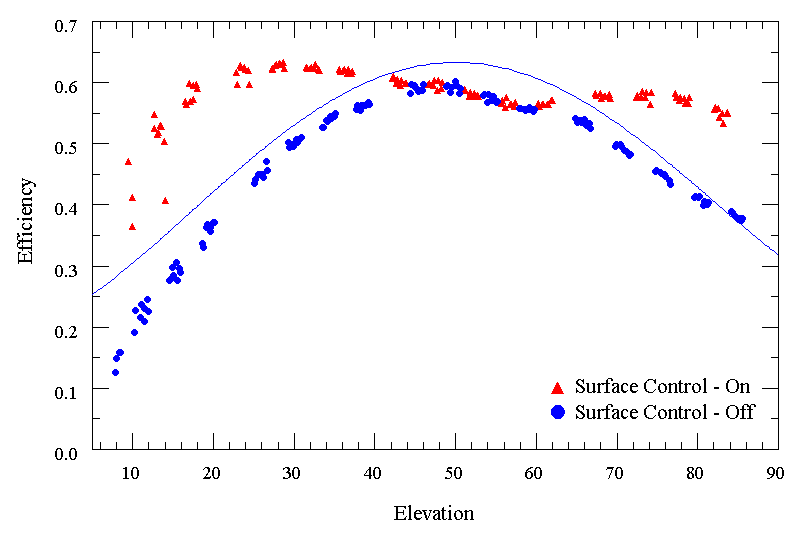
GBT News Update
6 May 2002
Phase I commissioning of the GBT (freq. < 15 GHz) is largely complete now and
Phase II commissioning (>18 GHz operation) is well underway. Pulsar, VLBI, and planetary radar observations are being run
routinely, and the first few spectral line programs are being conducted.
Blind pointing accuracy is ~7" and offset pointing accuracy is
3-4". First sidelobes are 30 dB below the main beam at low
frequencies, and the image quality afforded by the unblocked aperture is
outstanding. 22 GHz operation has just begun, and we have had a major success with the first use of the active surface of the GBT.
During the winter, a number of significant pulsar observations were carried out on the GBT, including the detection of new millisecond pulsars in M62
(Jacoby et al.; see gbtpulsarsjan02.html) and the
first detection of the radio pulsar in 3C58, the youngest pulsar known (Camilo et al.; see
http://www.aoc.nrao.edu/pr/3c58.html). These
observations made use of the Berkeley-Caltech Pulsar Machine (BCPM). VLBI observations are now
scheduled routinely and VLBA observing files can be converted to GBT command tables and executed automatically. A number of
planetary radar programs have also been run using Arecibo and Goldstone radar transmissions.
Last fall, we began a concerted effort to commission spectral line capability and to conduct the first scientific programs
of this type. This was achieved, and work continues to develop capabilities
further and to refine performance. We have conducted a major program to develop the GBT Spectrometer. At
present, a number of modes have been commissioned, including the 50 MHz, 9 level; 800 MHz, 3 level; and 12.5 MHz, 9 level (work in progress).
By mid-March, all four quadrants of the Spectrometer were operational, a major
milestone in the project. Work on remaining modes continues as a priority
task.
The major commissioning initiative this spring has been to develop 22 GHz
(K-band) capability. This campaign required a number of development efforts that
included generalizing the control system to accommodate K-band observing,
commissioning the K-band receiver itself, introducing beam-switched observing,
developing the 800 MHz bandwidth mode of the Spectrometer, and commissioning the
open loop active surface.
The active surface implementation uses a look-up table generated from the Finite Element Model (FEM) of the GBT structure. The model is computed as a function of elevation angle at the beginning of each scan, and the Active Surface Manager commands all 2209 actuators to move to position. The entire system worked extremely well on the first night it was tried. The gain-elevation curve was substantially flattened (Figure 1) and the sidelobe response at low elevation was markedly improved. The overall aperture efficiency of the dish is about 55% at 22 GHz, which indicates that the the RMS surface accuracy is about 450 microns at present. This surface accuracy was achieved through results of photogrammetry measurements made over a year ago.

Figure 1 -- Aperture efficiency measurements as a function of elevation with the active surface corrections on (red) and off (blue). The observations were made by tracking sources across the sky. At each elevation angle, the source was measured first with the active surface on, then off. The solid blue curve is the theoretical prediction of the Finite Element Model.
The K-band commissioning campaign has been quite successful and all major goals were achieved. The first astronomical project at K-band was run in late April. Refinements are continuing now and will be addressed further in the fall when K-band weather returns.
The current commissioning campaign is focused on bringing the GBT into routine operation by the end of this summer, for all standard observing modes. Specific goals of the campaign are to make it fast and easy to configure all systems at the start of an observing run, to make all control and sub-systems robust and reliable, and to verify and release all major autocorrelation modes of the Spectrometer.
In addition to commissioning activities, a number of major maintenance activities are planned for the summer, which include painting and structural inspections. We are also continuing to work on some significant issues related to the azimuth track. At the beginning of this year, we noticed some apparent deterioration of the grout below the splice plates, which support the track joints. In addition, as the azimuth wheels roll over a track joint, we have measured increased side-to-side motion of the wheel, and more vertical deflection of the track plates with respect to the concrete foundation. Considerable analysis and measurement have gone into this issue over the past few months. To test a possible remedy, last week we removed a section of grout below one splice plate and have replaced it with a new epoxy grout. The test will be evaluated over the next few weeks in regard to strength and stability and whether the side-to-side motion of the wheels is reduced. Based on the outcome of these tests, we will decide whether to proceed with a grout replacement over the remainder of the track.
P. R. Jewell